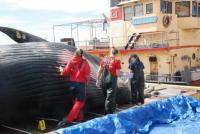 Fin and sei whale are not usually seen in New York’s upper harbor, yet in a period of less than a month, two have made an appearance. Unfortunately, both were dead, pinned to the bows of ships.
Fin and sei whale are not usually seen in New York’s upper harbor, yet in a period of less than a month, two have made an appearance. Unfortunately, both were dead, pinned to the bows of ships.
On the April 12th, a 65′ fin whale was found in Port Elizabeth, carried in on the bow of a container ship. Last Sunday, a 45′ sei whale was carried into the harbor by the cruise ship Norwegian Breakaway. The dead whale may have been related to damage to one of the ship’s pod propulsion units. The damage delayed the ship’s docking by three hours, much to the displeasure of at least some of the 4,500 passengers aboard the ship. Evidence of striking the whale was found on the bow of the cruise ship. A necropsy of the female sei whale was not able to determine whether the whale was alive or not when it was hit by the cruise ship. Fin and sei whales are the second and third largest whales in the ocean, respectively. Both species are endangered.
While the focus in much of the media has been on Japanese “research” whaling, ship strikes pose a far greater risk to endangered whales. Most ship strikes go unreported. On the East Coast, the focus in the past few years has been the highly endangered right whales. With only about 425 North Atlantic right whales in existence, these whales are among the most endangered in the world. In 2008, the National Oceanographic and Atmospheric Administration (NOAA) imposed a “ship strike reduction rule” requiring ships to slow down while operating in areas in which the right whales are known to migrate. The rules appear to be effective. No right whale strikes have been reported since the rule came into effect.
On the West coast, NOAA reports: In California, ship strikes of gray whales are the most commonly reported followed by fin, blue, humpback, and sperm whales. When large vessels such as container ships are involved, the ships crew may be unaware a strike has occurred. As such, the number of ship strikes to whales is likely under reported. Between 1988 and 2012, there were 100 documented large whale ship strikes along the California coast.
NOAA has made changes in shipping lanes and mandated some slower ship speeds to help reduce the number of whales run down by ships. Internationally, the International Whaling Commission (IWC ) and the International Maritime Organization (IMO) have been working to develop rules and standards to reduce ship strikes, as well.
Based on what we have seen in New York harbor in the last month alone, however, there is much left to be done.
